Dendritic spine pathologies in hippocampal pyramidal neurons from Rett syndrome brain and after expression of Rett-associated MECP2 mutations
- PMID: 19442733
- PMCID: PMC2722110
- DOI: 10.1016/j.nbd.2009.05.001
Dendritic spine pathologies in hippocampal pyramidal neurons from Rett syndrome brain and after expression of Rett-associated MECP2 mutations
Abstract
Rett syndrome (RTT) is an X chromosome-linked neurodevelopmental disorder associated with the characteristic neuropathology of dendritic spines common in diseases presenting with mental retardation (MR). Here, we present the first quantitative analyses of dendritic spine density in postmortem brain tissue from female RTT individuals, which revealed that hippocampal CA1 pyramidal neurons have lower spine density than age-matched non-MR female control individuals. The majority of RTT individuals carry mutations in MECP2, the gene coding for a methylated DNA-binding transcriptional regulator. While altered synaptic transmission and plasticity has been demonstrated in Mecp2-deficient mouse models of RTT, observations regarding dendritic spine density and morphology have produced varied results. We investigated the consequences of MeCP2 dysfunction on dendritic spine structure by overexpressing ( approximately twofold) MeCP2-GFP constructs encoding either the wildtype (WT) protein, or missense mutations commonly found in RTT individuals. Pyramidal neurons within hippocampal slice cultures transfected with either WT or mutant MECP2 (either R106W or T158M) showed a significant reduction in total spine density after 48 h of expression. Interestingly, spine density in neurons expressing WT MECP2 for 96 h was comparable to that in control neurons, while neurons expressing mutant MECP2 continued to have lower spine density than controls after 96 h of expression. Knockdown of endogenous Mecp2 with a specific small hairpin interference RNA (shRNA) also reduced dendritic spine density, but only after 96 h of expression. On the other hand, the consequences of manipulating MeCP2 levels for dendritic complexity in CA3 pyramidal neurons were only minor. Together, these results demonstrate reduced dendritic spine density in hippocampal pyramidal neurons from RTT patients, a distinct dendritic phenotype also found in neurons expressing RTT-associated MECP2 mutations or after shRNA-mediated endogenous Mecp2 knockdown, suggesting that this phenotype represent a cell-autonomous consequence of MeCP2 dysfunction.
Figures
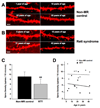

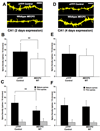
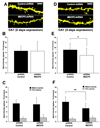

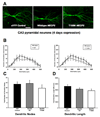
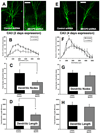
References
-
- Akbarian S, Chen RZ, Gribnau J, Rasmussen TP, Fong H, Jaenisch R, Jones EG. Expression pattern of the Rett syndrome gene MeCP2 in primate prefrontal cortex. Neurobiol Dis. 2001;8:784–791. - PubMed
-
- Amir RE, Van den Veyver IB, Wan M, Tran CQ, Francke U, Zoghbi HY. Rett syndrome is caused by mutations in X-linked MECP2, encoding methyl-CpG-binding protein 2. Nat Genet. 1999;23:185–188. - PubMed
-
- Armstrong D, Dunn JK, Antalffy B, Trivedi R. Selective dendritic alterations in the cortex of Rett syndrome. J Neuropathol Exp Neurol. 1995;54:195–201. - PubMed
-
- Asaka Y, Jugloff DG, Zhang L, Eubanks JH, Fitzsimonds RM. Hippocampal synaptic plasticity is impaired in the Mecp2-null mouse model of Rett syndrome. Neurobiol Dis. 2006;21:217–227. - PubMed
Publication types
MeSH terms
Substances
Grants and funding
LinkOut - more resources
Full Text Sources
Other Literature Sources
Medical
Molecular Biology Databases
Miscellaneous

